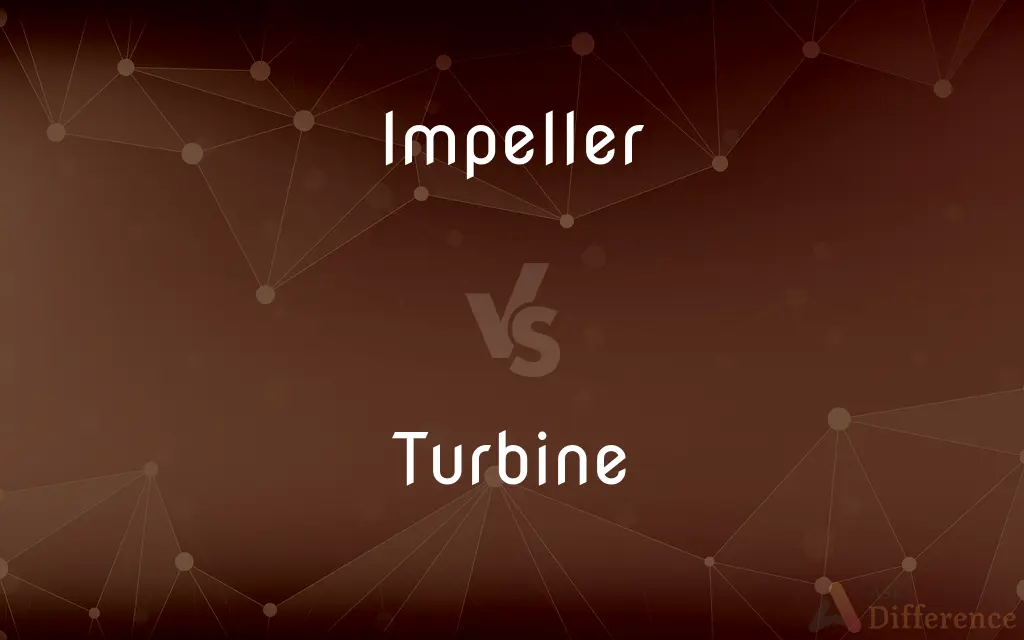Impeller vs. Turbine — What's the Difference?
By Tayyaba Rehman — Updated on November 7, 2023
An impeller is a rotating component of a pump that transfers energy to the fluid, while a turbine is a machine that extracts energy from a fluid flow to generate power.

Difference Between Impeller and Turbine
Table of Contents
ADVERTISEMENT
Key Differences
Impellers and turbines are both critical components in mechanical and energy systems, yet they serve different functions. An impeller is designed to push fluid by rotating inside of a pump, thereby transferring energy to the fluid. This process is critical for the movement of fluids in systems like aquarium filters or heating systems. Turbines, conversely, are designed to extract energy from moving fluids. They convert the kinetic energy of gases or liquids into mechanical energy as they pass through the turbine blades.
In a pump with an impeller, the rotation of the impeller imparts velocity to a liquid, causing a build-up of pressure that forces the fluid through the pump. In contrast, a turbine such as those found in windmills or hydroelectric power plants, is acted upon by fluid dynamics; the moving fluid rotates the turbine's blades, thus generating electricity or mechanical work. The direction of energy transfer is the primary distinction: impellers put energy into a fluid, turbines take energy out.
While impellers are enclosed within the pump housing and work by accelerating the fluid radially outward from the pump shaft to the pump casing, turbines typically consist of a series of angled blades around a shaft that may be horizontal or vertical, depending on the application. Impellers are often found in small-scale applications and work on the principle of displacement, while turbines are part of large-scale energy production, relying on fluid flow and dynamic pressure.
In practical applications, impellers and turbines can look somewhat similar because both have blades and both rotate. However, the shape, design, and angle of the blades differ because they are optimized for their specific function—impellers for moving fluids with as little energy loss as possible, and turbines for capturing as much fluid energy as possible. Understanding these differences is crucial for engineers and technicians who work with pumps and energy generation systems.
Comparison Chart
Function
Pushes fluid in a pump
Extracts energy from fluid flow
ADVERTISEMENT
Energy Transfer
Transfers energy to the fluid
Extracts energy from the fluid
Blade Design
Radial and designed to displace fluid
Aerodynamic, designed for energy efficiency
Applications
Aquariums, heating systems, small-scale pumps
Windmills, hydroelectric plants, power generation
Flow Direction
Radial outward from the center
Passes fluid through the blades axially or radially
Compare with Definitions
Impeller
A device that increases the pressure and flow of a fluid.
The impeller's efficiency determines the pump's overall performance.
Turbine
A rotary engine that extracts energy from a fluid or gas.
Jet engines use turbines to produce thrust from high-speed exhaust gases.
Impeller
A component that is vital for the operation of a centrifugal compressor.
The new impeller design improved the compressor's efficiency by 15%.
Turbine
A component found in both renewable and non-renewable energy systems.
The steam turbine needs maintenance for optimal energy production.
Impeller
A rotating component within a pump.
The motor turns the impeller, which circulates water in the tank.
Turbine
Utilized in power generation from wind or water.
Wind turbines on the ridge produce energy for the surrounding community.
Impeller
A blade rotor that drives fluid radially in a centrifugal pump.
He replaced the worn-out impeller to restore the pump's function.
Turbine
A machine with blades that convert energy from a fluid flow.
The hydroelectric plant's turbine converts water power into electricity.
Impeller
Used in small machinery to move liquids.
The machine's impeller ensures continuous fluid motion for cooling.
Turbine
A turbine ( or ) (from the Greek τύρβη, tyrbē, or Latin turbo, meaning vortex) is a rotary mechanical device that extracts energy from a fluid flow and converts it into useful work. The work produced by a turbine can be used for generating electrical power when combined with a generator.
Impeller
An impeller or impellor is a rotor used to increase the pressure and flow of a fluid. It is the opposite of a turbine, which extracts energy from, and reduces the pressure of, a flowing fluid.
Turbine
A machine for producing continuous power in which a wheel or rotor, typically fitted with vanes, is made to revolve by a fast-moving flow of water, steam, gas, air, or other fluid.
Impeller
The rotating part of a centrifugal pump, compressor, or other machine designed to move a fluid by rotation.
Turbine
Any of various machines in which the kinetic energy of a moving fluid is converted to mechanical power by the impulse or reaction of the fluid with a series of buckets, paddles, or blades arrayed about the circumference of a wheel or cylinder.
Impeller
One that impels, as a rotating device used to force a fluid in a desired direction under pressure.
Turbine
Any of various rotary machines that use the kinetic energy of a continuous stream of fluid (a liquid or a gas) to turn a shaft.
Impeller
A rotor or rotor blade.
Turbine
A water wheel, commonly horizontal, variously constructed, but usually having a series of curved floats or buckets, against which the water acts by its impulse or reaction in flowing either outward from a central chamber, inward from an external casing, or from above downward, etc.; - also called turbine wheel.
Impeller
Something which or someone who impels.
Turbine
A type of rotary engine with a set of rotating vanes, diagonally inclined and often curved, attached to a central spindle, and obtaining its motive force from the passage of a fluid, as water, steam, combusted gases, or air, over the vanes. Water turbines are frequently used for generating power at hydroelectric power stations, and steam turbines are used for generating power from coal- or oil-fired electric power stations. Turbines are also found in jet engines, and in some automobile engines.
Impeller
A rotating component that accelerates fluid outward from a center of rotation, found in devices such as pumps, water jets, washing machines, and agitated tanks.
Turbine
Rotary engine in which the kinetic energy of a moving fluid is converted into mechanical energy by causing a bladed rotor to rotate
Impeller
One who, or that which, impels.
Turbine
Features aerodynamic blades optimized for energy efficiency.
Advancements in turbine blade design have greatly increased energy outputs.
Impeller
The blade of a rotor (as in the compressor of a jet engine)
Common Curiosities
Are impellers and turbines interchangeable?
No, they have different functions and are not interchangeable.
What are the typical applications of an impeller?
Impellers are commonly used in pumps for water circulation, in heating systems, and in other fluid transfer applications.
What is an impeller?
An impeller is a rotating component in a pump that pushes fluid by imparting energy to it.
Where are turbines typically used?
Turbines are used in power generation, as in wind, hydroelectric, steam, and gas turbines.
What is a turbine?
A turbine is a device that extracts kinetic energy from fluids (like gas or liquid) and converts it into mechanical energy.
Can an impeller generate power like a turbine?
No, impellers are designed to move fluid, not to generate power.
Do impellers work on the principle of displacement?
Yes, impellers work on the principle of displacement to move fluids.
What is the main difference in blade design between an impeller and a turbine?
Impeller blades are designed to displace fluid efficiently, while turbine blades are designed to capture energy from fluid flow.
Can a turbine operate in a vacuum?
No, turbines require a fluid or gas flow to operate.
What material are impellers typically made from?
Impellers are often made from metals, plastics, or composites depending on the application requirements.
How do turbines produce electricity?
Turbines convert the kinetic energy of moving fluids to mechanical energy, which is then used to generate electricity.
Are impellers found in compressors?
Yes, impellers are key components in centrifugal compressors.
Can impellers and turbines look similar?
They might look similar due to their rotating blades, but their designs are optimized for different functions.
Do turbines only work with water?
No, turbines can work with any fluid, including water, steam, and air.
Is an impeller part of a turbine?
No, an impeller is not part of a turbine; they are distinct components.
Share Your Discovery

Previous Comparison
Secondly vs. Secondarily
Next Comparison
Tedious vs. MundaneAuthor Spotlight
Written by
Tayyaba RehmanTayyaba Rehman is a distinguished writer, currently serving as a primary contributor to askdifference.com. As a researcher in semantics and etymology, Tayyaba's passion for the complexity of languages and their distinctions has found a perfect home on the platform. Tayyaba delves into the intricacies of language, distinguishing between commonly confused words and phrases, thereby providing clarity for readers worldwide.














































